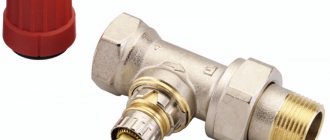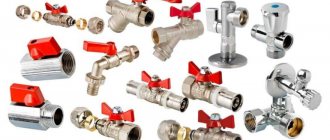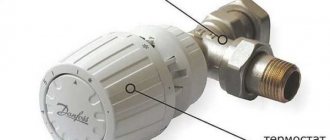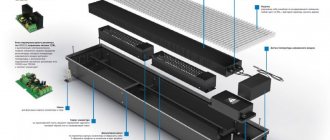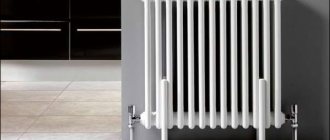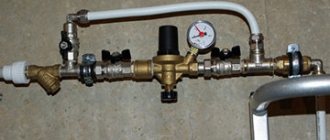The thermostatic head for heating radiators belongs to the control valves of a water heating system. Experts call it a radiator valve or a thermostatic valve. The device appeared in Russia relatively recently, and was immediately included in the appropriate regulatory framework as a legitimate element of a water heating system.
The thermostat is designed to regulate the heating level of one heating radiator or a chain of series-connected batteries. With its help, you can set an individual temperature regime in one of the rooms of your house or apartment. The versatility of the device lies in the fact that it is compatible with any radiator models.
How important and necessary is a thermal head?
The thermostatic head for a heating radiator allows you to optimize energy consumption, which can bring significant savings in thermal energy throughout the heating season. Using a heating boiler, you can raise or lower the heating temperature in all heating radiators at the same time.
However, this is not always necessary, since different rooms have different needs for the level of heating. The bedroom, children's, living room, dining room and hall need a temperature of 200 - 220, in the bathroom a comfortable level of air heating is desirable around 240 C, and in utility rooms 160 C is sufficient.
Level 120 and 70 for special occasions. By installing thermostatic heads, homeowners can adjust the temperature in each room according to their wishes.
Thermal head device
To make it clearer what the device is capable of and how best to use it, we need to consider what it consists of and on what principle it functions.
The thermostat head is a sealed hollow cylinder, inside of which there is a bellows - a container with a working substance. The bellows senses changes in air temperature in the room through the slots of the rotating plastic cap.
The head body is connected to the valve with a special nut. The lower figure shows a sectional view of an angle faucet with a thermal head for a radiator. As can be seen in the diagram, the thermal head consists of 10 elements.
Common Mistakes
Correct installation requires attentiveness from the master at every stage of work in order to avoid mistakes. The most common problem is the vertical position of the head. This leads to the fact that the room stops heating, since the thermostat itself heats up from the incoming air.
Often the wrong installation location is chosen. You cannot install the regulator at a point where the air temperature is very different from the average in the room. Due to the wrong choice of installation location, the use of a thermal head loses its meaning.
Principle of operation
The operation of a thermal head for a heating radiator is as follows:
- Markings on the rotary ring indicate the 4 main positions of the regulator. By combining a certain mark on the scale with the body mark, the operating mode of the device is set;
- if the air begins to heat up above the established norm, then through the slots of the rotary cap it begins to heat the bellows with the working substance;
- the heated substance begins to increase in volume, which sets the rod in motion;
- the rod, in turn, begins to close the passage hole through the spool, thereby reducing the flow of coolant into the battery;
- as a result, the air in the room will begin to cool, and the bellows with the working fluid will cool accordingly;
- the reverse process occurs, and hot water will be supplied to the radiator with the required intensity.
The control and accuracy of adjustment may vary between devices. However, the operating principle is the same for all mechanical models.
Thermal head, how it works, experiment.
Kinds
According to the method of transmitting the signal to the thermal element, it can come from the coolant, indoor air. The valve of different types can be almost identical. They will differ in the thermal head. Today, all existing varieties can be divided into 2 types: mechanical and electronic. Devices have their own characteristics, which affect their performance characteristics.
The devices differ not only in the type of material, but also in the installation method. They can be of angular or straight (pass-through) type, depending on the type of connection. For example, if the main is connected to the side, a direct type valve is installed. The corner method is used when connecting from below. The valve option is chosen to be the one that fits best into the system.
The choice between them depends on the preferences of the buyer and his financial capabilities. Products can be designed for a specific type of thermoelement. To understand the differences between thermostats, you need to briefly note their main nuances.
Mechanical
Mechanical thermostats are easy to use, precise and consistent in use. They do not need a network connection. Manual products are different from their electronic counterparts. They work on the principle of a regular faucet: the regulator is turned in the desired direction, allowing the required amount of coolant to flow through. The devices are cheap, but not the most convenient, since to change the heat transfer you need to manually turn the valve each time.
If you install them instead of ball valves, you can use any of them to adjust. The devices are technologically advanced and do not require preventive maintenance. However, often there are no markings at the inlet and outlet of radiators of this design to adjust the heating temperature. Almost always you have to set it experimentally.
Before installing such structures, it is necessary to adjust them, as well as install hydraulic resistance. Smooth adjustment is carried out due to the throttle mechanism, which is located inside the device. This can be done on one of the valves (inlet or return). The operation of a mechanical thermostat depends on the hot and cold points inside the room, as well as the direction of air movement in the room. Another disadvantage is the fact that they react to the operation of household appliances with their own thermal circuits (for example, refrigerators, electric heaters, and hot water pipes).
Electronic
Such modifications are more complex in design compared to manual analogues. With their help you can make your heating system flexible. They not only allow for temperature control of an individual radiator, but also provide control of the main components of the system, including the pump and mixers. Depending on the model, programmable devices are equipped with different types of sensors.
The electronic mechanism can measure the ambient temperature of a specific space (the place where it is installed). Using the software, the received data is analyzed and a decision is made to reduce or increase the temperature. Such a mechanism can be analog or digital. The digital version has 2 modifications: its logic can be open or closed.
The difference between the categories is that products with closed logic are not able to change the functioning algorithm. They remember the level of the initially set temperature and maintain it. Analogs of open logic are able to independently select the desired control program. However, they are rarely used in domestic conditions, since it will be difficult for the average buyer to initially program them, selecting the desired options from the many built-in functions.
Types of thermal heads
Thermal heads for batteries are divided into devices based on the type of built-in mechanisms:
- manual;
- mechanical;
- electronic.
Manual
In their operation, temperature control devices resemble the operation of an ordinary water tap. Turn the knob to regulate the intensity of the coolant flow entering the radiator. The scale was calibrated based on a series of instrument tests. Each division corresponds to the temperature that should be established in the room.
pros
Low cost of the device. Easy to install and handle. Beautiful appearance.
Minuses
The degree of heating of the battery is set manually using the thermostat head. This means that adjusting the temperature in the room is impossible while the owners of the home are sleeping or absent.
Mechanical
The thermostat rod closes, and the passage of the coolant in the pipe in front of the radiator is cleared, moving automatically following the bellows changing in volume. The temperature value is set manually using the scale of the rotary cap, setting restrictions on the operation of the thermostatic valve.
pros
The situation when the presence of the owners is required to adjust the device is eliminated. The thermostat maintains the set parameter around the clock, which significantly saves thermal energy.
Minuses
The need for constant monitoring of the correct installation and execution of the specified temperature conditions by the device.
Electronic
The automatic thermal head with electronic control has an expanded range of functions. The principle of operation of the thermostat is the same as that of a mechanical device. The head has the ability to fine-tune. The thermal head is installed directly on the thermostatic valve and makes it possible to regulate the air temperature in the room.
pros
The advantages include the presence of such functions as:
- programming the device temperature modes for each day of the week;
- “Boost” enables rapid heating of the battery;
- “Vacation” sets a constant heating mode for the entire period of long absence of the owners in the house or apartment;
- “Offset” is triggered when access is difficult or the battery is located in a deep niche;
- "Open window" When opening the windows, the head will automatically lower the heating temperature of the radiator.
Minuses
The disadvantages include the high cost of an automatic thermostat head. This should also include the need to monitor batteries and timely replacement of AA batteries.
Thermal heads for heating radiators differ in the mounting method - these are:
- taps with thermal heads, straight and angular;
- wireless;
- with remote sensor.
Valves with thermal heads - straight and angular
These include all manual and mechanical devices (see chapters “Manual” and “Mechanical” above). Straight (through) models have a tee for inserting into a straight pipe.
Corner thermal heads are installed in the corners of rotation of the heating main in front of the heating radiator.
Wireless
A special feature of wireless thermostat heads for heating batteries is that they are controlled via Bluetooth from a smartphone or tablet. Wireless thermostats are completely independent devices that do not require additional equipment. The main advantages of such devices are:
- the ability to control not only remotely, but also using touch buttons located on the thermal head body;
- programming for each day of the week or for a longer period;
- the presence of self-learning functions, child protection, warning of rod oxidation and open window recognition.
With remote sensor
The remote sensor is an elongated non-ferrous metal flask filled with liquid. The flask is connected by a steel tube with a bellows, through which the liquid moves in one direction or another depending on the increase or decrease in the air temperature in the room.
A bellows is a container with accordion-shaped walls, so it can both expand and contract by acting on the valve stem.
A 2 meter long connecting tube allows you to place the remote sensor in any convenient place.
Electronic thermostatic head device.
The electronic thermostat for a heating radiator has a fairly simple device. All elements of these devices are assembled in a compact housing, which is screwed onto the radiator valve. The sensor monitors the external temperature readings. It transmits readings to the controller, which sends signals to the executive shut-off valves. No human intervention is required when adjusting the temperature.
In addition to the listed elements, electronic thermostats for heating radiators include a display. It displays detailed information about the selected settings, the current temperature indicator - both external and coolant temperature. To control the device, use the buttons on its front panel. Devices with remote control capabilities using a remote control are also available for sale.
Basic criteria for choosing a thermal head
Today, the heating engineering market is filled with a wide range of thermal heads of various designs, mostly manufactured by branded companies. In order for the consumer not to get confused among this variety of models, experts recommend being guided by the following selection criteria.
- It is advisable to select thermal heads from the same manufacturer for heating radiators.
- When choosing a device, you should give preference to those models that require a minimum of additional fittings and fastening and connecting elements.
- If a small room includes one or two living rooms, then it is advisable to install manual valves with thermal heads in each of them.
- In one-story buildings, it is advisable to install mechanical thermostats and thermostat heads with remote sensors.
- In two and three story townhouses, owners can choose to have wireless thermostatic heads. They must be installed in houses connected to the Smart Home system.
- The products of a branded manufacturer, compared to mass-produced counterfeits, despite their high cost, will not let you down for many years.
- The anti-vandal casing will protect against careless attempts to interfere with the device settings.
- The design of the thermal head should not contrast with the background of the radiator and fit harmoniously into the interior of the room.
- In order not to run into a fake, you need to ask the seller for a quality certificate.
Correct installation
Thermostats can be installed both at the input of the heating battery and at the output, the main thing is to choose the right installation location. There are several recommendations for this.
Recommended installation height, which is specified in the technical specifications of the device. The main technical characteristics are developed at the factory, through testing and calibration, which are carried out at a certain height. This height corresponds to the upper radiator manifold. Typically this corresponds to a height of about 0.8 meters. At this height it is convenient to carry out all manipulations with this device.
Installation diagrams for heat regulators for radiators
When connecting batteries at the bottom (saddle), when the pipes are located only at the bottom, you need to look for appropriate thermostats. As an option, you can install a thermostat with a remote temperature sensor or reconfigure the thermostat, which is not so simple and is unlikely to be possible without specialists.
The installation technology is no different from the installation technology of conventional shut-off valves, but taking into account the direction of movement of the coolant.
When installing thermostats on radiators in apartment buildings, you should take into account the fact that all apartments are connected to the system. If you do not install a bypass, in the form of a pipe that connects the upper and lower pipes, then the thermostat will regulate the temperature of all apartments connected to the riser.
If you have a similar wiring (there may not be a pipe on the right), a bypass is required. The thermostat should be installed immediately behind the radiator
It is quite natural that no one needs this: neither the neighbors, nor the owner of the apartment. Moreover, such a connection can result in a considerable fine if the relevant services find out.
Installing a thermal head on a heating radiator
Connecting a thermostat to a radiator consists of two operations - installing a thermostatic valve and installing a thermal head.
How to install a THERMAL HEAD on a heating radiator with your own hands
Radiator valve installation
Winding flax thread onto the valve outlet threads
Winding flax thread onto the thread of the supply pipe
We coat the winding with sealant
Securing the valve seat
Installing the valve on the pipe
Connecting the valve to the radiator
Valve installed
Installing a thermal head
Install the thermostat as follows:
Set the regulator to the maximum open position
We screw the thermal head onto the valve thread
The thermostat must be installed perpendicular to the radiator
Installation sequence
Connection diagram of the thermal head to the battery
Installation of the thermal head begins with cutting the pipes. It must be performed at a short distance from the radiator. Next, the old shut-off valves are demonstrated, the valve shanks are separated and screwed into the battery plugs.
Then the piping is assembled and installed and the pipes on the sides of the batteries are connected. By turning the lever, the required temperature is set. The thermostatic head for radiators can be mounted at the inlet or outlet of the system.
When choosing an installation location, the manufacturer's recommendations must be followed. Basically, the installation height is 0.4-0.6 meters from the floor. It is to this value that the temperature regime is calibrated. Such criteria are met with top feed. If it is lower, you need to adjust the thermal head to a colder temperature.
Features of setting up the Danfoss electronic thermal head
adjusting the valve and thermostat of the thermal battery
By default, the thermostat is set to the energy saving program P 1. You can select the program that best suits your family's lifestyle:
- P 0 – constant temperature 210 C around the clock.
- R 1 – energy saving, in which every night from 22-30 to 6 am the temperature is maintained at 170 C.
- R 2 - an extended energy-saving program, which raises temperatures up to 170 C every night from 22-30 to 6 am and on weekdays from 8 am to 16 pm.
- You can create your own settings in the energy saving program. To do this, press the middle button of the program menu and select the desired one. Using the arrow keys, you can set energy saving periods for weekends, weekdays, all days of the week, or one day.
- Once the settings have been selected, they are confirmed by pressing the bottom key.
How to choose
Based on the characteristics of the heating system, as well as the conditions of its installation, various combinations of valves and thermal heads can be used to control the temperature.
So, for example, for use in single-pipe systems it is worth using valves with a higher throughput.
The same applies to those two-pipe systems in which water circulation is carried out by gravity, that is, naturally, without forced mechanisms. In cases where a two-pipe system is used where there is a circulation pump, it is recommended to choose those types of valves where it is possible to adjust the throughput.
After selecting the valve, you need to select the thermal head.
The most common options that can be purchased today are:
- having an internal thermoelement;
- electronic (which can be programmed);
- having an external temperature sensor;
- anti-vandal;
- having an external regulator.
Most often, classic thermostats with an internal sensor version are installed in cases where their axis will be in a horizontal position.
Please note: the thermostat cannot be installed vertically, as the heat emanating from the housing piping will greatly affect the bellows, causing the entire device to function incorrectly.
In addition to vertical installation options, there are also other reasons to purchase a remote version of the sensor:
- if heating radiators with a temperature regulator located on them will be located behind the curtains;
- when there is any other heat source next to the installed thermal head;
- if the location of the battery is under a large window sill.
Very often, in rooms where interior requirements are increased, batteries are covered with decorative screens. Due to this, the internal thermostat will only register the temperature that is inside this casing. In this case, access to the thermal head adjustments will be blocked. Therefore, in such cases, it is recommended to opt for a remote controller with a temperature sensor.
It’s worth knowing: if you haven’t purchased heating radiators yet, you can buy Kermi models with built-in temperature sensors.
If we talk about electronic thermostats with a display, then they come in several types; the first have a built-in control unit, and the second have a removable control unit. The latter have the peculiarity of being able to be disconnected from the thermal head, while it will continue to operate in the same mode. The purpose of such models is to regulate the temperature in different modes at different times of the day. This makes it possible to reduce the heat level during the day, and at night, when everyone in the house is sleeping, to raise it to the desired level. Due to this, it is possible to significantly save energy.
If there are small children in the family who always want to touch and twirl everything, it is recommended to install anti-vandal thermostats. This will protect the device settings from unauthorized intervention. The same situation applies to options installed in various public buildings, from kindergartens to hospitals.
Rating of popular manufacturers
Lists of the most popular manufacturers of thermal heads help the consumer to correctly navigate the wide range of thermostats for radiators on the heating engineering market. Based on an analysis of information published on the Internet, the following number of companies is presented:
- Valtec;
- Danfoss;
- Oventrop;
- Thermo;
- Honeywell;
- Caleffi;
- Salus.
Valtec
The company produces reliable heating devices and thermostatic heads. The brand is of Italian origin, although all production facilities are located in Southeast Asia. One of the models of thermostatic heads presented on the Russian market, VT.1000.0.0, allows you to automatically regulate the coolant flow with high accuracy depending on the set temperature in the room.
pros
High precision settings. Beautiful design. Long service life.
Minuses
So far there have been no negative reviews.
Danfoss
The well-known Danish company Danfoss has been developing energy-saving technologies for more than 60 years. Its products, and in particular thermal heads, are very popular in the Russian heating engineering market. Programmable electronic devices are often included in the Smart Home system. The microclimate in the house can be controlled by software installed on a smartphone via WI-FI.
pros
High efficiency, reliability, beautiful design.
Minuses
High cost of the device.
Oventrop
The success of one of the leaders in the production of fittings for utility networks, including thermostats for radiators, Oventrop, was achieved due to the high qualifications of the engineering staff and the rest of its employees. The most popular models of thermostats are the Uni line. The devices are equipped with a liquid bellows, designed for the maximum temperature in the heating system - 1200 C.
pros
Easy to use. Beautiful appearance. Accuracy of settings.
Minuses
Not compatible with all types of radiators. High price of the device.
Thermo
Founded more than 20 years ago, the Swedish company Thermo quickly took a leading position in the production of heating equipment. Thermal heads from this manufacturer are widely recognized and lead in most ratings. The Royal Thermo RTE 50.30 model should be noted. It is valued for its wide adjustment range - from 6 to 28 degrees Celsius.
pros
Beautiful appearance. Easy to operate. Fits into the interior of any room
Minuses
For correct operation, the coolant must have a temperature of no more than 95 degrees.
Honeywel
An American company specializing in the production of electronic automation control systems is known in Russia as a manufacturer of reliable and efficient heating equipment. Electronically controlled thermal heads feature precise settings.
pros
Beautiful design, simple installation and ease of use.
Minuses
There is no such information yet.
Caleffi
The Italian company Caleffi produces fittings for utility networks for various purposes. In Russia, the company is known as a manufacturer of high-quality thermal heads. One of the programmable Caleffi 210000 models is equipped with a liquid crystal display. Has a large number of settings.
pros
Accuracy of settings. High efficiency and ease of use. Beautiful design.
Minuses
There have been no negative reviews yet.
Types of heads by design
Thermostatic devices are distinguished by type of design. They are selected depending on the characteristics of the pipeline of a particular heating system and the method of installation to the radiator.
It is also necessary to take into account the peculiarities of the head installation. This node was always located horizontally. In this position the device will be more effective. The head will be better washed by air currents.
There are devices on sale that stand alone without radiator valves or together with them. The Danfoss thermostatic valve, for example, has exactly this arrangement. But the company produces completely different systems. Instead of a scale, this product has a special diagram on it, according to which you can make precise adjustments.
But the use of such equipment is not always advisable. In this case, instead of automatic solutions, you can use other types of valves. The difference here is that the adjustment is carried out not automatically, but in manual mode. Adjustable valves and thermal heads are installed on the supply line. It is recommended to install simpler fittings at the return outlet from the battery.

